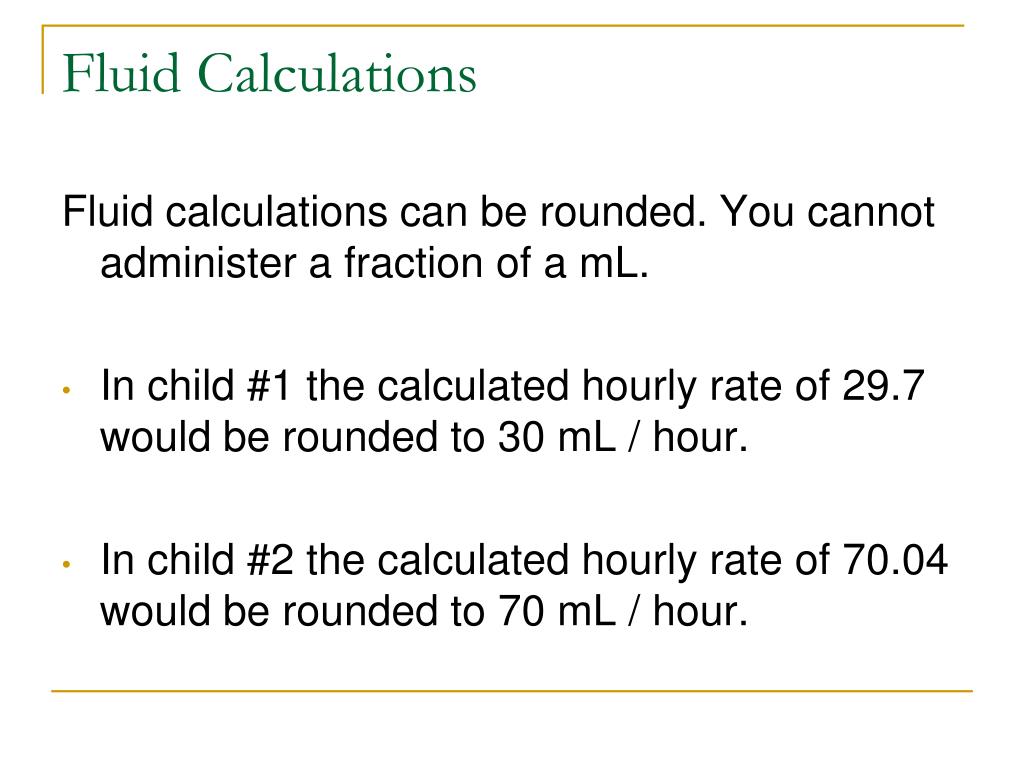
4 Calculating percentage dehydration by weight Percentage dehydration may be calculated either clinically or by weight. The U&Es and plasma glucose should be monitored at least every 24 hours, or more frequently if there are electrolyte abnormalities. diarrhoea, vomiting) supplement with potassium (e.g. Use isotonic crystalloid that contains sodium with added glucose (e.g. Replacement fluids should be adjusted according to existing electrolyte excess or deficit and any anticipated ongoing losses (e.g. If this is impractical or contraindicated, IV fluid therapy may be considered with volumes based on the percentage-dehydration.

Maintenance for term neonates is calculated according to their age and weight: 1įor patients with dehydration without clinical features of shock, rehydration via the oral or nasogastric route is preferred. The next step is to calculate the infusion rate in mL/hourįor the above case, this would be 1900/24 which equals 79 mL/h Neonates (< 28 days of age) 5Ĭalculate the 24-hour maintenance fluids and hourly infusion rate for a 40kg child:

50 ml/kg/day for the next 10kg of weightĪn online calculator for routine maintenance fluids by the Holliday-Segar formula can be found here.100 ml/kg/day for the first 10kg of weight.Routine maintenance fluids for children are calculated by weight using the Holliday-Segar formula: 1,5 Routine maintenance fluid Choice of fluid Child (>28 days of age)įor a child (>28 days of age), first line maintenance fluid is usually isotonic crystalloids + 5% glucose (e.g. You might also be interested in our OSCE Flashcard Collection which contains over 2000 flashcards that cover clinical examination, procedures, communication skills and data interpretation. Hypotension is a sign of decompensated shock and indicates that the child is critically unwell. They will compensate until they become very unwell and then deteriorate rapidly. Clinical shockĬlinical shock is defined by the presence of one or more of:Ĭhildren have a large physiological reserve.
#MAINTENANCE FLUID CALCULATOR PEDS SKIN#
Reduced skin turgor of the abdominal skin. *These clinical features are red flags, the presence of which may predict a higher risk of progression to shock.
#MAINTENANCE FLUID CALCULATOR PEDS FULL#
Routine maintenance fluid therapy is required if the current oral intake is not sufficient to remain hydrated.įor example, if the patient is ‘nil by mouth’ for any significant period, full maintenance fluids will be required.Īlternatively, if the patient can obtain some of their intake orally, but is not completely meeting their fluid requirements, they may be given a percentage of full maintenance fluids based on their intake. In these cases, it is necessary to determine the indication for fluids, type of fluid and volumes/infusion rate required.īroadly there are three indications for IV fluids in infants and children: routine maintenance, replacement and resuscitation. However, there are certain situations where the oral route is contraindicated or impractical. oral rehydration solution) via the oral or nasogastric route should be used.

You might also be interested in our prescribing question bank which contains over 250 questions.


 0 kommentar(er)
0 kommentar(er)
